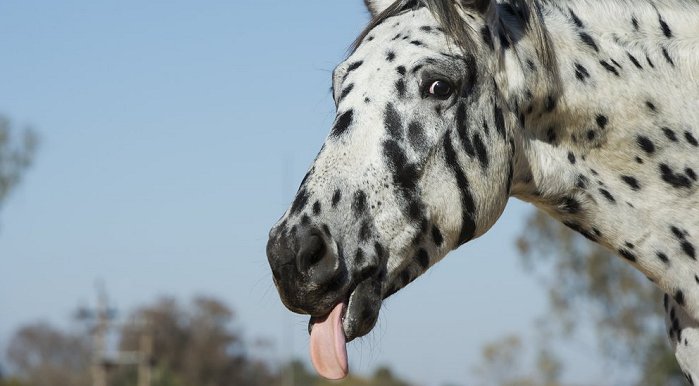The tongue is a fat muscle that lies easily inside the bottom mouth cavity. When relaxed, it is flat and flaccid pressing gently against the roof of the mouth (palate). The bit sits across the tongue. In a relaxed state, the horse is able to gently “carry” the bit by holding it against his palate on top of his tongue with a little bit of muscle tension. This seems to be quite comfortable for a horse, and he will do it automatically with a little bit of care in the selection of the bit and gentle rider hands.
Remember the statement, “The tongue is the gateway to the neck, shoulders, and front of the horse.” As his training progresses, the more comfortable we can make his mouth and tongue, the more relaxed and receptive he becomes.
The back of the tongue is attached to the hyoid bone which is attached to his jaw bones and is the origination of the two most important neck muscles: one to the sternum and one to the inside shoulder. This relationship is the basis for the theory that a “stiff” tongue produces a “stiff” neck or vis-a-versa: a relaxed tongue encourages a relaxed horse. When the tongue moves back, the muscles tense. When the tongue forward, the muscles are relaxed.
The horse begins to move his tongue back in preparation for swallowing or forward for relaxation.
When a horse begins to lick and chew during or after performing an exercise, he is visibly relaxing his mouth, face, neck and shoulders. It is a much-sought-after result of a lesson. I believe it indicates that he has finally understood what is being asked and is prepared to perform without stress. It is a time to “chew his lesson over” and think his way to relaxation during his maneuver.
I am sure you can think of psychologically “up tight” things you have had to accomplish that tighten your neck and shoulders until you ache. Then, when the task becomes routine, you relax those muscles and begin to enjoy the work.
Additionally, many riders believe that a bit that encourages salivation gets the tongue moving and relaxes the muscles responsible for tension and swallowing. Relaxing his face and shoulders should make him breathe more easily and perform more smoothly. In my opinion, the jury is still out on whether “artificial” salivation accomplishes the same thing as natural relaxation. But, at least, a bitted, salivating horse is keeping the bit wet and mobile and more comfortable in his mouth.

Hello, I have a Tb gelding,10yrs old!
I show him and generally any other activities, which we have been successful, but He has an issue with lopping his tongue out to the right! I have his teeth regularly checked and have tried numerous bits etc,,
This is only usually when I take a contact, he does it with any rider, and always have since I had him as a broken 3yr old from training! Please help!
Hi Charlotte:
Thank you so much for participating.
I am not an expert on bits by any means, but I do a lot of riding without one using a side-pull. One way to test if it is the bit that is causing a problem: go to the arena and ride the canter without a bit at all. If his tongue still lolls out of his mouth, then the bit is not the issue. If you pick up on the rein without a bit and he is sound in the face, it is probably either the bit or your hands.
There are some facts about horse anatomy that can cause bitting issues. Because a horse can either swallow or breathe (but not both at the same time), his tongue must be able to move freely in his mouth. A horse’s gait is synchronized with his breathing: one breath for every stride. A bit that interferes with that will cause him to try to find a solution. Sometimes that is the tongue outside the mouth cavity.
If you must have a bit, have you used a Myler bit? They are specifically designed to relieve tongue pressure, and there is a whole philosophy around their design.
Here are a couple of pages of information on bridles without bits. They might be of use to you.
http://horse-pros.com/6983/side-pull-bitless-bridle
http://horse-pros.com/5665/bitless-bridle
Jax